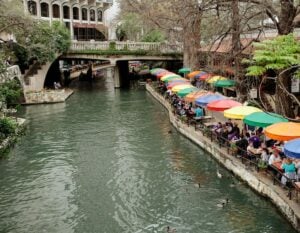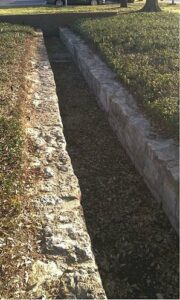San Antonio is known for the scenic Riverwalk and The Alamo, but did you know they are also unique for their water and natural gas systems? Today, the City of San Antonio has been recognized for its innovative, eco-friendly water and natural gas processing plant.
 Early settlers used the San Antonio river for clean drinking and bathing water, as well as supplying their farmlands with clean water. Today, the Edwards Aquifer and San Antonio Water System provide citizens with plenty of water they need in their daily lives.
Early settlers used the San Antonio river for clean drinking and bathing water, as well as supplying their farmlands with clean water. Today, the Edwards Aquifer and San Antonio Water System provide citizens with plenty of water they need in their daily lives.
Does San Antonio have good drinking water?
 Yes! Water is filtered and brought to San Antonio citizens mainly from the from the Edwards Aquifer. SAWS also mentions that our water also comes from Carrizo, Trinity, and Wilcox aquifers. If you prefer to filter the tap water, for taste or other reasons, there are a wide variety of filtration devices. Whole home filtration systems, such as the one by Aquasauna, filter the water before it even enters the home. On the other hand, there are also under-the-sink filters that filter tap water at the sink faucet.
Yes! Water is filtered and brought to San Antonio citizens mainly from the from the Edwards Aquifer. SAWS also mentions that our water also comes from Carrizo, Trinity, and Wilcox aquifers. If you prefer to filter the tap water, for taste or other reasons, there are a wide variety of filtration devices. Whole home filtration systems, such as the one by Aquasauna, filter the water before it even enters the home. On the other hand, there are also under-the-sink filters that filter tap water at the sink faucet.
Want to learn more about water filtration systems? Visit our page about how to get safe drinking water with a reverse osmosis system.
If you want to avoid an install all together you may consider a filtered pitcher or water bottle. They range in price wildly, so consider looking at a few models before making any decisions.
Water filtration in most cases is only to err on the side of caution. Most cities have a water authority in place to make sure your water is safe to drink. San Antonio Water System even provide water quality reports for most areas. See your area’s quality report on the SAWS website.
How is the water cleaned in San Antonio?
San Antonio has extremely unique water treatment facilities. Recently, the city discovered a new way to use waste water. Waste water is usually burned off, but San Antonio had the idea to use it for renewable energy. A case study provided by Ameresco, shows just how committed San Antonio is to green, renewable energy.
“By reusing biogas instead of burning it off, we are helping protect the city’s air quality and developing a renewable energy source.”
– Robert R. Puente
President/CEO, San Antonio Water Supply
The new system of renewable energy benefits the environment and citizens. The environmental effects can be seen over time as the gas is not burned in the city. We Are Water Foundation reported that carbon dioxide is one of the main greenhouse effects. Instead of that Co2 going into the atmosphere Ameresco reports that the project boasts an annual reduction of 19,739 tons of Co2. Less carbon dioxide is entering the atmosphere every single year due to San Antonio’s quick thinking on renewable energy.
In return The City of San Antonio does receive royalties on the sale of the gas. However, that money goes right back into the community, which benefits the city and its citizens. Benefits include the 115 million gallons of water recycled daily and used by citizens of San Antonio. While this study was only recently published in 2023, it provides insights on how much the city saves on greenhouse gasses and money.
Why is San Antonio Water so Hard?

Most of the water feeding into San Antonio comes from Edwards aquifer, and the aquifer is unique in the fact that it holds its water in limestone. Surprisingly enough, the limestone is the main cause of San Antonio’s water hardness, information in thanks to Pure Water Blog. Limestone deposits calcium and magnesium into the water, which can cause damage to appliances plus cause pipe build-up over time.
Any appliance that moves water is subject to build-up. Over time, sinks, toilets, water heaters, and more can obtain build-up in the unit or worse, in the pipes surrounding the unit. That’s why it is especially important in San Antonio to check up on your plumbing and look into getting your water heater flushed every 1 – 2 years. This will help flush out the particles and debris that should not be in your pipes.
In addition you can also have a water softener installed. Just like a t-shirt or blanket can get softer, so can your water. The water softener’s resin beads absorb the calcium and magnesium, and return sodium ions to the water. Energy Saver explains that once the water moves through the system in this way, the water is no longer hard. Since the water comes directly from The Edwards limestone aquifer, it may be something to consider for your home or business.
What is the Source of the Drinking Water in San Antonio?

San Antonio gets most of its water from a limestone aquifer known as Edwards Aquifer, and it is fiercely protected by citizens. The citizens even voted on a tax, that stands to this day, to protect the 135,000 plus acres of aquifer. According to SA Tomorrow, the SAWS Water Management Plan has expanded the aquifer another 69,000 by 2020 and plans to add another 100,000 acre feet of water annually by 2026.
San Antonio also conserves the Edwards aquifer water by recycling used water in everyday occurrences. Instead of recycled waste water going into the rivers, sometimes it is redirected to businesses. The SAWS water recycling program consists of 110 miles of pipelines delivering recycled water to parks, golf courses, commercial and industrial customers, and more as San Antonio grows. Despite San Antonio’s growing size, water conservation is and will always be the way of life for citizens. Water has always been a top priority for anyone living in the region, including some of San Antonio’s earliest residents.

At Reliant Plumbing, we believe in helping support our community. That’s why we have given back through a business membership to Pines and Prairies. Learn more about their commitment to nature conservation.
Water is Vital to the San Antonio Community.
A safe, clean source of drinking water originally drew settlers to the area. For centuries, inhabitants of San Antonio and central Texas have relied on the area’s abundant aquifers to sustain their activities. The history of the city of San Antonio can be told through the value of clean drinking water.
According to SAWS, in 1716 the war between the Spanish and the French continued into New England. This eventually caused the river to become compromised for the locals. Early San Antonio citizens had to create a new way to use water, or find a new water source, before a French invasion compromised their way of life.
San Antonio was first settled in June 1691 by Domingo Teran de los Rios, accompanied by Fray Massanet. This team of leaders with their communities in tow headed to East Texas to try to secure Spanish territory. They would soon discover what is now known as the San Antonio River, a fresh stream of water with a promising future for their settlement.
 Discovering The San Antonio River
Discovering The San Antonio River
In April of 1709, Father Antonio de San Buenaventura Y Olivares had stopped at the future San Antonio River for water. On the report of San Antonio Water Supply, or SAWS, Father Antonio was so impressed by the river, and friendly Payayas Native Americans, that he petitioned for a formal settlement. Commonly referred to as a mission, these settlements helped the Spanish gain control of the eastern Texas territories and ultimately the San Antonio River.
Captain Domingo Ramon was then sent out on a new expedition to inspect Father Antonio’s river site while heading out to East Texas. Not too far from the newly found river, Captain Domingo’s crew would soon discover the San Pedro springs. The spring was named aptly after the St. Peter’s Feast Day which was taking place on the same day as the spring’s discovery in 1716. The mission was settling in well and that drew attention from other struggling missions.
Prosperous Life for Settlers

By 1731, Mission San Antonio de Valero and Mission San Jose y San Miguel were joined by three other missions that moved from East Texas. Mission Concepción, Mission San Juan Capistrano and Mission San Francisco de la Espada all were built out and around the river. According to SAWS, the Coahuiltecan people were living around the river before the Spanish arrived, and had built a water movement system that ran water alongside the river. They used this system to water their acres of farm lands that grew a series of corn, black beans, and sugar cane. Eventually the Spanish developed missions with such an abundance of food, water, and shelter that some of the Coahuiltecan people moved into the settlements. Most eventually joined the various San Antonio River missions and brought their knowledge of the area’s water. The Spanish Colonials then had all the tools they needed to construct these acequias for their own settlements.

What Are Acequias?
Acequias are a series of expansive irrigation systems comprising dams, irrigation canals, and gates. They are very unique because they used gravity to move water to different missions versus more traditional methods. Author Waynne Cox of The Spanish Acequias of San Antonio, states that most of these started out with a device to contain and direct the water into the channel, such as a diversion dam. Then the Acequia Madre, or the main ditch, would have jutted out from the structure. The main canal of water also contained sluice gates, at points all along the acequia, that would open up and allow the water to irrigate into the specific farmlands that needed the water the most. SAWS mentions that the water was fiercely protected, “Rows of cactus plants were even planted along either side of the acequia to keep cattle and other livestock away from the water.” Each settlement would come to build their own acequia, and a few are extremely noteworthy to San Antonio’s history.

Early days of Acequia Concepción
The acequia Concepción, also called Pajalache, is possibly one of the oldest acequias of San Antonio. Remember earlier when the water drew in more settlers? Mission San Jose originally used and maintained this acequia, and once Mission Concepción relocated to San Antonio in 1731 it then needed to be expanded to accommodate two more missions worth of settlers. The King William Association recently discovered the acequias location under St. Mary’s Street. Just imagine all the water that used to hold!
Acequia Concepción
Acequia Concepción quickly became one of the largest water systems in the area. Cox mentions that Concepción “flowed alongside the west side of the road to the lower missions to a point 2,500 feet from the intake”. The water was then carried across by Acequia Madre de Valero. Additions were added to this acequia in the mid 18th century replacing an older system of water travel with a “substantial arched stone aqueduct” which helped the water continue to flow alongside the road to the mission compound. The aqueduct ends when it makes a westward turn back to the San Antonio River. Concepción was originally built with a whooping 3.3 miles of extensive canals, acequias, and dams, except it did not stop there. After all the different expansions, especially after Mission Concepción’s arrival, Acequia Concepción finished off with 7.5 miles of ditches before its retirement in 1869. In fact, according to The City Of San Antonio, it is even rumored that the canals were so wide that small boats or canoes could float down the acequia de Concepción. Sections of this acequia are still preserved at the old Big Tex Industrial complex and Yturri-Edmunds complex. This infamous acequia received its water from the Acequia Madre de Valero, an area now known today as The Alamo.
Acequia Madre de Valero
In general terms, an Acequia Madre is the term for the supply of water that supplies other acequias. An example of that is the Acequia Madre de Valero, as this was the acequia Concepcións main water source. A Texas State University study shows that the 1719 Acequia Madre was the first part of San Antonio’s acequia system. Valero was originally designed to be only 3.5 miles long, but because of the new Mission Concepción moving in next to the original San Jose location, plans changed. These missions now had more people and farmland than their 3.5 miles of acequias could accommodate.
Madre Valero’s impact on Acequia Concepción
Early mission settlers took on construction of the canal from 1724 to 1744 with the goal of carrying enough water back to Mission San Antonio de Valero and the newly added Mission Concepción. Construction started at the bend of the river flowing through what is now the Witte Museum, and finally emptying out in the San Antonio river about 3.5 miles down. Once Mission Concepción settled by the river, next to Mission Valero, they expanded the acequia system to accommodate the new farmlands and people of both missions.
“branching near the mission and irregulating additional farm lands to the south, extended its total to approximately 10 miles.”
– Waynne Cox
Author, The Spanish Acequias of San Antonio
That is a whole 7.5 miles added, nearly triple the previous amount! If you want to visit this acequia, it is still viewable on the trails of HemisFair Park, as well as near a pond behind the east wall of The Alamo, providing valuable information to the length of the acequia. By 1718 acequias were being built not only on the missions, but for the City of San Antonio itself.
History of Water Contamination in San Antonio
Starting in the 1800’s the citizens of San Antonio now had an issue with waste water. Some citizens were even forced to dig trenches to dispose of waste including trash and fecal matter, according to SAWS. Those trenches over time spilled into the rivers, putting all the missions in jeopardy of illness or spreading disease. The missions of the San Antonio River came together to form public regulation after the contamination of the river occurred.
San Pedro Acequia 
The San Pedro acequia, or also called Acequia de Principal, was solely for cooking and drinking purposes. In fact, The City Of San Antonio reports that the San Pedro acequia that was built solely for the military and civilian populations. This constant supply of clean water kept waste water and trash out of the river. The settlers even had sections for clean bathing water. SAWS states that the “… San Pedro Creek and the San Antonio River were for bathing and laundry. Fines were imposed on offenders.” The clean water was fiercely protected, and thankfully it had paid off. The city of San Antonio has and will always protect the acequias, including a map on all the standing acequia locations. San Antonio eventually grew over the decades, and today the city continues to add new innovations to its water systems.
Local San Antonio Plumbers Committed to Water Quality
Do you need plumbing services in San Antonio? Certified technicians in San Antonio can help you make the safest and healthiest choice for your family and home. Our San Antonio plumbers have experience with the plumbing challenges home owners may face across within the Texas hill country. We have a deep understanding of this region, its’ water, and can help you have the best water and sewage system for your budget.

 Discovering The San Antonio River
Discovering The San Antonio River

